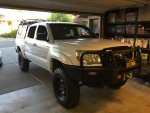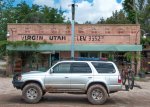Dipodomys
Observer
I stayed with the stock 265/70/16 tires for the first few rounds of tires on my 2008 Tacoma. They looked a little puny on my modestly lifted truck (OME 886 springs in front and OME Dakar leafs with extra leaf in back...about 2.5 to 3 inches total lift). I didn't want to spend the money on larger tires and I also didn't want to impact the performance of my engine and transmission.
This time I decided to go with something different. After much research I settled on the BF Goodrich KM2 255/85/16. This tire is talked about a lot in the overland community, but I have seen very few actually out on the road. This is a "mud" tire, and it is tall and relatively skinny. It has a military look to it, particularly with steel rims. Not everyone likes that look, but I do. See the photos.
The stock 265/70/16 tire is about 30.5 inches high and about 10.5 inches wide. The 255/85/16 is 33.1 inches high and only 10 inches wide. The height difference is substantial, and will add about 1.5 inches to the height of your vehicle.
I also took the opportunity to ditch the not-very-attractive Toyota SR5 package alloy rims that came with my truck, which I've never been crazy about. I went with the stock steel rim...the same the spare tire is mounted on. They are crude but effective. They cost $105 each from Olathe Toyota (https://parts.olathetoyota.com/auto-parts), who, by the way, have the lowest prices I've found on OEM Toyota parts, even if you factor in shipping costs.
Here are my impressions of this tire, mounted on my 2008 Tacoma Dual Cab:
Noise: The aggressive tread is a little bit noisier, but not overly so. My wife hasn't mentioned anything, and if she'd noticed anything she would have let me know.
Height/Lift: The difference in truck height is noticeable. That's OK with me, as it adds 1.5 inches of additional clearance under the axles, differentials, and body. It's not ridiculously (AKA stupidly) high, though. I'm not into monster trucks.
Effect on Engine/Transmission Performance: The performance hit from the taller tire is substantial, and was greater than I had expected. I knew it might be a problem, but I think I had some wishful thinking that it wouldn't be too bad. Well, it is. It's fine on level roadways and in most highway driving conditions, but once you hit a hill you really notice. Lots of downshifting and not a lot of get-up-and-go. On a recent trip to Lake Tahoe on U.S. 50, there was no way that I could pass like I used to, as the engine couldn't gain speed on hills without really downshifting and screaming. That was not the case formerly. On the return trip over Sonora Pass (CA State Route 108; very windy and steep), I actually found myself manually shifting my 5-speed automatic all the way to Low gear to keep the engine from lugging around the super-steep and curvy stretches. The transmission couldn't seem to find the right gear, and always selected a gear that was too high. This was at very low speeds (<15 mph). Sadly, a ring-and-pinion change is in order. $$$. I could probably live with it as-is, but I really liked the former performance of my engine/transmission and would like to regain it. I would say that this height of tire is the absolute maximum you can go without a gearing change. It is marginally acceptable as it is, and would be completely unacceptable if it were any worse, at least in my opinion.
Speedometer: Your speedo will be off with any increase in tire height. Mine is now off about 10 percent or so. That means the speedo says I'm going 65 when I'm really going over 70. The fix is a gearing change or one of those speedo correction kits, and I've heard mixed reviews about those. Again, those clever engineers designed your vehicle for a specific engine/transmission/gearing combination. If you mess with that substantially you'll have to pay the piper. It's just like any modification from stock.
Looks: When I first saw them mounted on my truck, I was surprised at how aggressive the tread was. I like a subtle-looking vehicle, with minimal bling. These tires have grown on me, however, and I'm now totally fine with it. The larger tires also filled out my wheel wells quite nicely. I like the look with the black steel rims. I doubt if the paint on the rims will hold up. When that happens, I'll get them powder coated.
Offroad performance: I aired them down to 20 psi for some moderately difficult offroad action in the Sierra and they performed beautifully. I am very pleased. These are very tough tires. For a "mud" tire, they are equally at home on rocky trails. We don't have much mud around here, only the rocky Sierras and desert, and I expect these will do just fine.
Handling: No noticeable difference from stock, but the greater height and subsequent higher center of gravity is something to keep in mind.
Wearability: At $230 a pop, I want these babies to last as long as possible, though I doubt they'll last anywhere near as long as a smaller, less aggressive tire. They guy at the tire shop recommended rotations every 3,500 miles, and alignments every 10,000 miles. That's the price I'll need to pay to keep these guys from wearing out before their time.
So that's my experience. All in all I love the tires, but the performance hit is something anyone should consider before they purchase this tire, or any tire that is substantially greater in size than what came stock. You'll either need to learn to live with it, or spend some serious bucks to correct it. There's no way around it.




This time I decided to go with something different. After much research I settled on the BF Goodrich KM2 255/85/16. This tire is talked about a lot in the overland community, but I have seen very few actually out on the road. This is a "mud" tire, and it is tall and relatively skinny. It has a military look to it, particularly with steel rims. Not everyone likes that look, but I do. See the photos.
The stock 265/70/16 tire is about 30.5 inches high and about 10.5 inches wide. The 255/85/16 is 33.1 inches high and only 10 inches wide. The height difference is substantial, and will add about 1.5 inches to the height of your vehicle.
I also took the opportunity to ditch the not-very-attractive Toyota SR5 package alloy rims that came with my truck, which I've never been crazy about. I went with the stock steel rim...the same the spare tire is mounted on. They are crude but effective. They cost $105 each from Olathe Toyota (https://parts.olathetoyota.com/auto-parts), who, by the way, have the lowest prices I've found on OEM Toyota parts, even if you factor in shipping costs.
Here are my impressions of this tire, mounted on my 2008 Tacoma Dual Cab:
Noise: The aggressive tread is a little bit noisier, but not overly so. My wife hasn't mentioned anything, and if she'd noticed anything she would have let me know.
Height/Lift: The difference in truck height is noticeable. That's OK with me, as it adds 1.5 inches of additional clearance under the axles, differentials, and body. It's not ridiculously (AKA stupidly) high, though. I'm not into monster trucks.
Effect on Engine/Transmission Performance: The performance hit from the taller tire is substantial, and was greater than I had expected. I knew it might be a problem, but I think I had some wishful thinking that it wouldn't be too bad. Well, it is. It's fine on level roadways and in most highway driving conditions, but once you hit a hill you really notice. Lots of downshifting and not a lot of get-up-and-go. On a recent trip to Lake Tahoe on U.S. 50, there was no way that I could pass like I used to, as the engine couldn't gain speed on hills without really downshifting and screaming. That was not the case formerly. On the return trip over Sonora Pass (CA State Route 108; very windy and steep), I actually found myself manually shifting my 5-speed automatic all the way to Low gear to keep the engine from lugging around the super-steep and curvy stretches. The transmission couldn't seem to find the right gear, and always selected a gear that was too high. This was at very low speeds (<15 mph). Sadly, a ring-and-pinion change is in order. $$$. I could probably live with it as-is, but I really liked the former performance of my engine/transmission and would like to regain it. I would say that this height of tire is the absolute maximum you can go without a gearing change. It is marginally acceptable as it is, and would be completely unacceptable if it were any worse, at least in my opinion.
Speedometer: Your speedo will be off with any increase in tire height. Mine is now off about 10 percent or so. That means the speedo says I'm going 65 when I'm really going over 70. The fix is a gearing change or one of those speedo correction kits, and I've heard mixed reviews about those. Again, those clever engineers designed your vehicle for a specific engine/transmission/gearing combination. If you mess with that substantially you'll have to pay the piper. It's just like any modification from stock.
Looks: When I first saw them mounted on my truck, I was surprised at how aggressive the tread was. I like a subtle-looking vehicle, with minimal bling. These tires have grown on me, however, and I'm now totally fine with it. The larger tires also filled out my wheel wells quite nicely. I like the look with the black steel rims. I doubt if the paint on the rims will hold up. When that happens, I'll get them powder coated.
Offroad performance: I aired them down to 20 psi for some moderately difficult offroad action in the Sierra and they performed beautifully. I am very pleased. These are very tough tires. For a "mud" tire, they are equally at home on rocky trails. We don't have much mud around here, only the rocky Sierras and desert, and I expect these will do just fine.
Handling: No noticeable difference from stock, but the greater height and subsequent higher center of gravity is something to keep in mind.
Wearability: At $230 a pop, I want these babies to last as long as possible, though I doubt they'll last anywhere near as long as a smaller, less aggressive tire. They guy at the tire shop recommended rotations every 3,500 miles, and alignments every 10,000 miles. That's the price I'll need to pay to keep these guys from wearing out before their time.
So that's my experience. All in all I love the tires, but the performance hit is something anyone should consider before they purchase this tire, or any tire that is substantially greater in size than what came stock. You'll either need to learn to live with it, or spend some serious bucks to correct it. There's no way around it.




Last edited:


